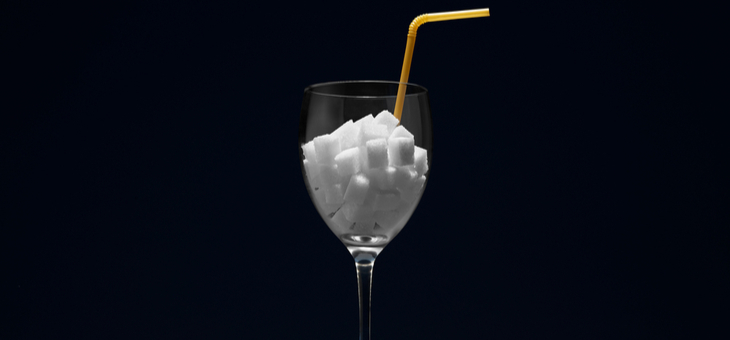The song, She Had Kisses Sweeter Than Wine, has been a hit several times over for a number of singers since the lyrics were first penned by Pete Seeger in 1951. Depending on your age, you might know the version recorded by Seeger’s band The Weavers at the time, Jimmie Rogers’ 1957 hit version or the Andy Williams rendition of 1967. A little bit of googling and you’ll have your answer.
But if you want to get an answer to the heart of the song’s message, just how sweet is wine, you won’t find it easy because, in Australia, wines containing alcohol are not required to carry a nutritional information label detailing the sugar content.
You know those labels – pretty much every item of packaged food you buy will have the familiar matrix, detailing serving size, the number of servings in the package, and the amounts of energy (kilojoules), protein, fats (saturated and otherwise), carbohydrates (including sugars) and other nutritional or non-nutritional items such as potassium.
Read: What happens when alcohol and anxiety mix
You’ll see these information boxes even on ‘junk’ foods such as potato chips and sweets because, in Australia, they are mandatory. A Nutritional Information Panel (NIP), as it is officially known, must be displayed on most items of food. According to the federal government’s statuary body Food Standards Australia New Zealand (FSANZ), there are a few exceptions to this rule, such as foods sold unpackaged, foods made and packaged at the point of sale (such as bread made and sold in a bakery) and items such as herbs, spices, packaged water, tea and coffee because they have no significant nutritional value.
Very little escapes the NIP net – unless it contains more than 1.15 per cent alcohol by volume. Under FSANZ’s Standard 1.2.8, “alcoholic beverages are exempt from the requirement to be labelled with a nutrition information panel” unless the beverage is making a nutritional claim (such as “high in fibre” or “low sugar”).
This rule has led to an anomalous and perhaps unintended consequence, whereby non-alcoholic wines must display an NIP panel, but alcoholic wines do not.
Read: Nine beverages that will give your brain a boost
Concerns about this surfaced in 2017 when the Australia and New Zealand Ministerial Forum on Food Regulation held a meeting during which the topic of sugar claims in relation to alcoholic beverages was raised.
A technical assessment responding to the forum published by FSANZ in 2018 stated that, “forum ministers are aware of an increasing number of alcoholic beverages for sale in Australia and New Zealand with the claim they are ‘% sugar-free’.
It noted that forum ministers were concerned that the claims on alcoholic beverages were misleading and that “alcohol is being promoted as a healthier choice for consumers when public health advice is to limit alcohol intake”.
The waters (not yet turned to wine) were muddied by another FSANZ Standard – 1.2.7 – which noted a lack of clarity about labels referring to carbohydrates (of which sugar is one) and sugar itself.
The assessment concluded with an acknowledgment that “to regulate claims about sugar differently to claims about ‘carbohydrate’ could be seen to be inconsistent” but made no formal recommendations.
Irene Falcone, CEO of Sans Drinks, a Sydney-based company that sells non-alcoholic wine and pre-mixed cocktails, all of which must contain NIPs, strongly believes that her alcoholic counterparts should be subject to the same scrutiny. “Alcoholic winemakers should absolutely include nutritional information – consumers are becoming increasingly aware of the harm caused by sugar and want to make informed decisions.”
Will it happen?
Maybe. In light of a growing chorus of calls to, “Show us your NIPs”, as it were, FSANZ is considering introducing energy labelling of alcoholic products. It recently published an Evidence Assessment Report, which concluded that, “unlike most other packaged food and beverages, labels on most packaged alcoholic beverages do not provide information about energy content to enable consumers to make informed choices in line with dietary guidelines. As labelling appears a potential approach to address the problem, FSANZ considers further consideration is warranted.”
Whether that will lead to material change is debatable. Associate Professor Gary Sacks, a Heart Foundation Future Leader Fellow based at the Global Obesity Centre (GLOBE) at Deakin University, says: “I wouldn’t say it’s a fait accompliabout what FSANZ will do, because we know from experience that the alcohol industry will very vocally oppose any regulations. There’s still a long road ahead for even energy labelling to get up.”
Read: Aussie supermarkets named and shamed as junk food pushers
For its part, the industry has not declared ‘formal’ opposition to the move. Andrew Wilsmore, CEO of Alcohol Beverages Australia, said: “We engaged early with FSANZ on its review into energy labelling, and provided constructive feedback as it progresses its review. At no stage during the consultation process did we say we opposed the move to label our products with energy information.”
For now, the waters remain muddied and the wine sugar content remains somewhat of a mystery, although new research by Alcohol Health Alliance UK found some bottles had up to 59 grams of sugar – more than a glazed doughnut.
If you can find someone whose kisses are sweeter than that, you’re doing very well – although some might argue that that person should come with a Nutritional Information Panel.
If you enjoy our content, don’t keep it to yourself. Share our free eNews with your friends and encourage them to sign up.

